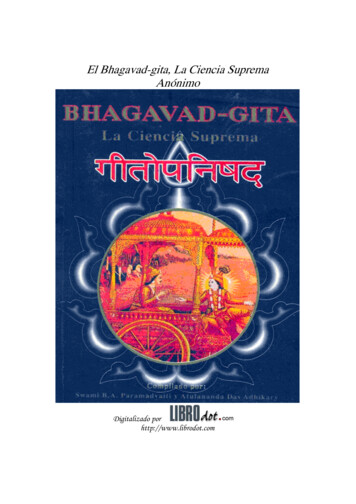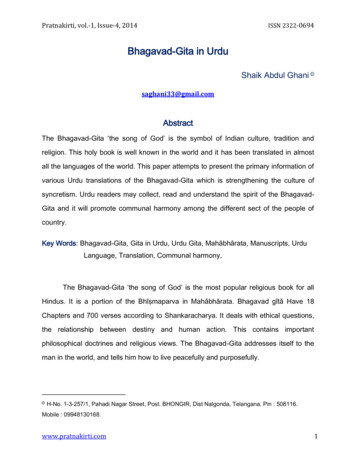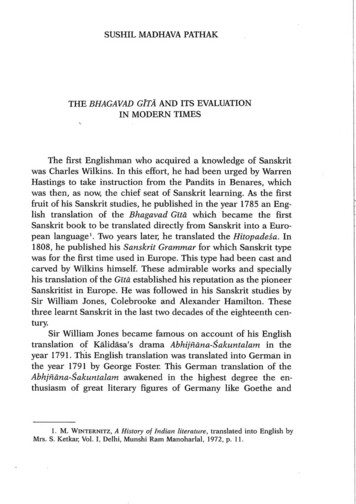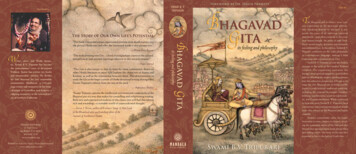
Transcription
PrefaceOriginally I wrote Bhagavad-gétä As It Is in the form in which it ispresented now. When this book was first published, the original manuscriptwas, unfortunately, cut short to less than 400 pages, without illustrations andwithout explanations for most of the original verses of the ÇrémadBhagavad-gétä. In all of my other books—Çrémad-Bhägavatam, Çré Éçopaniñad,etc.—the system is that I give the original verse, its English transliteration,word-for-word Sanskrit-English equivalents, translations and purports. Thismakes the book very authentic and scholarly and makes the meaningself-evident. I was not very happy, therefore, when I had to minimize myoriginal manuscript. But later on, when the demand for Bhagavad-gétä As It Isconsiderably increased, I was requested by many scholars and devotees topresent the book in its original form. Thus the present attempt is to offer theoriginal manuscript of this great book of knowledge with full paramparäexplanation in order to establish the Kåñëa consciousness movement moresoundly and progressively.Our Kåñëa consciousness movement is genuine, historically authorized,natural and transcendental due to its being based on Bhagavad-gétä As It Is. Itis gradually becoming the most popular movement in the entire world,especially amongst the younger generation. It is becoming more and moreinteresting to the older generation also. Older gentlemen are becominginterested, so much so that the fathers and grandfathers of my disciples areencouraging us by becoming life members of our great society, theInternational Society for Krishna Consciousness. In Los Angeles many fathersand mothers used to come to see me to express their feelings of gratitude formy leading the Kåñëa consciousness movement throughout the entire world.Some of them said that it is greatly fortunate for the Americans that I havestarted the Kåñëa consciousness movement in America. But actually theCopyright 1998 The Bhaktivedanta Book Trust Int'l. All Rights Reserved.
original father of this movement is Lord Kåñëa Himself, since it was started avery long time ago but is coming down to human society by disciplicsuccession. If I have any credit in this connection, it does not belong to mepersonally, but it is due to my eternal spiritual master, His Divine Grace OàViñëupäda Paramahaàsa Parivräjakäcärya 108 Çré Çrémad BhaktisiddhäntaSarasvaté Gosvämé Mahäräja Prabhupäda.If personally I have any credit in this matter, it is only that I have tried topresent Bhagavad-gétä as it is, without any adulteration. Before mypresentation of Bhagavad-gétä As It Is, almost all the English editions ofBhagavad-gétä were introduced to fulfill someone’s personal ambition. But ourattempt, in presenting Bhagavad-gétä As It Is, is to present the mission of theSupreme Personality of Godhead, Kåñëa. Our business is to present the will ofKåñëa, not that of any mundane speculator like the politician, philosopher orscientist, for they have very little knowledge of Kåñëa, despite all their otherknowledge. When Kåñëa says, man-manä bhava mad-bhakto mad-yäjé mäànamaskuru [Bg. 18.65], etc., we, unlike the so-called scholars, do not say thatKåñëa and His inner spirit are different. Kåñëa is absolute, and there is nodifference between Kåñëa’s name, Kåñëa’s form, Kåñëa’s qualities, Kåñëa’spastimes, etc. This absolute position of Kåñëa is difficult to understand for anyperson who is not a devotee of Kåñëa in the system of paramparä (disciplicsuccession). Generally the so-called scholars, politicians, philosophers, andsvämés, without perfect knowledge of Kåñëa, try to banish or kill Kåñëa whenwriting commentary on Bhagavad-gétä. Such unauthorized commentary uponBhagavad-gétä is known as Mäyäväda-bhäñya, and Lord Caitanya has warned usabout these unauthorized men. Lord Caitanya clearly says that anyone whotries to understand Bhagavad-gétä from the Mäyävädé point of view willcommit a great blunder. The result of such a blunder will be that the misguidedstudent of Bhagavad-gétä will certainly be bewildered on the path of spiritualguidance and will not be able to go back to home, back to Godhead.Our only purpose is to present this Bhagavad-gétä As It Is in order to guidethe conditioned student to the same purpose for which Kåñëa descends to thisplanet once in a day of Brahmä, or every 8,600,000,000 years. This purpose isstated in Bhagavad-gétä, and we have to accept it as it is; otherwise there is noCopyright 1998 The Bhaktivedanta Book Trust Int'l. All Rights Reserved.
point in trying to understand the Bhagavad-gétä and its speaker, Lord Kåñëa.Lord Kåñëa first spoke Bhagavad-gétä to the sun-god some hundreds of millionsof years ago. We have to accept this fact and thus understand the historicalsignificance of Bhagavad-gétä, without misinterpretation, on the authority ofKåñëa. To interpret Bhagavad-gétä without any reference to the will of Kåñëa isthe greatest offense. In order to save oneself from this offense, one has tounderstand the Lord as the Supreme Personality of Godhead, as He wasdirectly understood by Arjuna, Lord Kåñëa’s first disciple. Such understandingof Bhagavad-gétä is really profitable and authorized for the welfare of humansociety in fulfilling the mission of life.The Kåñëa consciousness movement is essential in human society, for itoffers the highest perfection of life. How this is so is explained fully in theBhagavad-gétä. Unfortunately, mundane wranglers have taken advantage ofBhagavad-gétä to push forward their demonic propensities and mislead peopleregarding right understanding of the simple principles of life. Everyone shouldknow how God, or Kåñëa, is great, and everyone should know the factualposition of the living entities. Everyone should know that a living entity iseternally a servant and that unless one serves Kåñëa one has to serve illusionin different varieties of the three modes of material nature and thus wanderperpetually within the cycle of birth and death; even the so-called liberatedMäyävädé speculator has to undergo this process. This knowledge constitutes agreat science, and each and every living being has to hear it for his owninterest.People in general, especially in this Age of Kali, are enamored by theexternal energy of Kåñëa, and they wrongly think that by advancement ofmaterial comforts every man will be happy. They have no knowledge that thematerial or external nature is very strong, for everyone is strongly bound bythe stringent laws of material nature. A living entity is happily the part andparcel of the Lord, and thus his natural function is to render immediate serviceto the Lord. By the spell of illusion one tries to be happy by serving hispersonal sense gratification in different forms which will never make himhappy. Instead of satisfying his own personal material senses, he has to satisfythe senses of the Lord. That is the highest perfection of life. The Lord wantsCopyright 1998 The Bhaktivedanta Book Trust Int'l. All Rights Reserved.
this, and He demands it. One has to understand this central point ofBhagavad-gétä. Our Kåñëa consciousness movement is teaching the wholeworld this central point, and because we are not polluting the theme ofBhagavad-gétä As It Is, anyone seriously interested in deriving benefit bystudying the Bhagavad-gétä must take help from the Kåñëa consciousnessmovement for practical understanding of Bhagavad-gétä under the directguidance of the Lord. We hope, therefore, that people will derive the greatestbenefit by studying Bhagavad-gétä As It Is as we have presented it here, and ifeven one man becomes a pure devotee of the Lord, we shall consider ourattempt a success.A. C. Bhaktivedanta Swami12 May, 1971Sydney, AustraliaIntroductionoà akñur unmélitaà yenatasmai çré-gurave � yena bhü-talesvayaà rüpaù kadä mahyaàdadäti sva-padäntikamI was born in the darkest ignorance, and my spiritual master opened myeyes with the torch of knowledge. I offer my respectful obeisances unto him.When will Çréla Rüpa Gosvämé Prabhupäda, who has established within thismaterial world the mission to fulfill the desire of Lord Caitanya, give meshelter under his lotus feet?Copyright 1998 The Bhaktivedanta Book Trust Int'l. All Rights Reserved.
vande ’haà çré-guroù çré-yuta-pada-kamalaà çré-gurün vaiñëaväàç caçré-rüpaà sägrajätaà saha-gaëa-raghunäthänvitaà taà sa-jévamsädvaitaà sävadhütaà parijana-sahitaà dän saha-gaëa-lalitä-çré-viçäkhänvitäàç caI offer my respectful obeisances unto the lotus feet of my spiritual masterand unto the feet of all Vaiñëavas. I offer my respectful obeisances unto thelotus feet of Çréla Rüpa Gosvämé along with his elder brother SanätanaGosvämé, as well as Raghunätha Däsa and Raghunätha Bhaööa, Gopäla Bhaööa,and Çréla Jéva Gosvämé. I offer my respectful obeisances to Lord KåñëaCaitanya and Lord Nityänanda along with Advaita Äcärya, Gadädhara,Çréväsa, and other associates. I offer my respectful obeisances to ÇrématéRädhäräëé and Çré Kåñëa along with Their associates Çré Lalitä and Viçäkhä.he kåñëa karuëä-sindhodéna-bandho jagat-pategopeça gopikä-käntarädhä-känta namo ’stu teO my dear Kåñëa, You are the friend of the distressed and the source ofcreation. You are the master of the gopés and the lover of Rädhäräëé. I offer myrespectful obeisances unto You.tapta-käïcana-gauräìgirädhe våndävaneçvarivåñabhänu-sute devipraëamämi hari-priyeI offer my respects to Rädhäräëé, whose bodily complexion is like moltengold and who is the Queen of Våndävana. You are the daughter of KingVåñabhänu, and You are very dear to Lord Kåñëa.väïchä-kalpatarubhyaç cakåpä-sindhubhya eva capatitänäà pävanebhyovaiñëavebhyo namo namaùCopyright 1998 The Bhaktivedanta Book Trust Int'l. All Rights Reserved.
I offer my respectful obeisances unto all the Vaiñëava devotees of the Lord.They can fulfill the desires of everyone, just like desire trees, and they are fullof compassion for the fallen é-advaita gadädharaçréväsädi-gaura-bhakta-våndaI offer my obeisances to Çré Kåñëa Caitanya, Prabhu Nityänanda, ÇréAdvaita, Gadädhara, Çréväsa and all others in the line of devotion.hare kåñëa hare kåñëakåñëa kåñëa hare harehare räma hare rämaräma räma hare hareBhagavad-gétä is also known as Gétopaniñad. It is the essence of Vedicknowledge and one of the most important Upaniñads in Vedic literature. Ofcourse there are many commentaries in English on the Bhagavad-gétä, and onemay question the necessity for another one. This present edition can beexplained in the following way. Recently an American lady asked me torecommend an English translation of Bhagavad-gétä. Of course in Americathere are so many editions of Bhagavad-gétä available in English, but as far as Ihave seen, not only in America but also in India, none of them can be strictlysaid to be authoritative because in almost every one of them the commentatorhas expressed his own opinions without touching the spirit of Bhagavad-gétä asit is.The spirit of Bhagavad-gétä is mentioned in Bhagavad-gétä itself. It is justlike this: If we want to take a particular medicine, then we have to follow thedirections written on the label. We cannot take the medicine according to ourown whim or the direction of a friend. It must be taken according to thedirections on the label or the directions given by a physician. Similarly,Bhagavad-gétä should be taken or accepted as it is directed by the speakerHimself. The speaker of Bhagavad-gétä is Lord Çré Kåñëa. He is mentioned onCopyright 1998 The Bhaktivedanta Book Trust Int'l. All Rights Reserved.
every page of Bhagavad-gétä as the Supreme Personality of Godhead,Bhagavän. Of course the word bhagavän sometimes refers to any powerfulperson or any powerful demigod, and certainly here bhagavän designates LordÇré Kåñëa as a great personality, but at the same time we should know thatLord Çré Kåñëa is the Supreme Personality of Godhead, as is confirmed by allgreat äcäryas (spiritual masters) like Çaìkaräcärya, Rämänujäcärya,Madhväcärya, Nimbärka Svämé, Çré Caitanya Mahäprabhu and many otherauthorities of Vedic knowledge in India. The Lord Himself also establishesHimself as the Supreme Personality of Godhead in the Bhagavad-gétä, and Heis accepted as such in the Brahma-saàhitä and all the Puräëas, especially theÇrémad-Bhägavatam, known as the Bhägavata Puräëa (kåñëas tu bhagavänsvayam). Therefore we should take Bhagavad-gétä as it is directed by thePersonality of Godhead Himself. In the Fourth Chapter of the Gétä (4.1–3) theLord says:imaà vivasvate yogaàproktavän aham avyayamvivasvän manave prähamanur ikñväkave ’bravét[Bg. 4.1]evaà paramparä-präptamimaà räjarñayo viduùsa käleneha mahatäyogo nañöaù parantapa[Bg. 4.2]sa eväyaà mayä te ’dyayogaù proktaù purätanaùbhakto ’si me sakhä cetirahasyaà hy etad uttamam[Bg. 4.3]Here the Lord informs Arjuna that this system of yoga, the Bhagavad-gétä,was first spoken to the sun-god, and the sun-god explained it to Manu, andCopyright 1998 The Bhaktivedanta Book Trust Int'l. All Rights Reserved.
Manu explained it to Ikñväku, and in that way, by disciplic succession, onespeaker after another, this yoga system has been coming down. But in thecourse of time it has become lost. Consequently the Lord has to speak it again,this time to Arjuna on the Battlefield of Kurukñetra.He tells Arjuna that He is relating this supreme secret to him becauseArjuna is His devotee and His friend. The purport of this is that Bhagavad-gétäis a treatise which is especially meant for the devotee of the Lord. There arethree classes of transcendentalists, namely the jïäné, the yogé and the bhakta,or the impersonalist, the meditator and the devotee. Here the Lord clearly tellsArjuna that He is making him the first receiver of a new paramparä (disciplicsuccession) because the old succession was broken. It was the Lord’s wish,therefore, to establish another paramparä in the same line of thought that wascoming down from the sun-god to others, and it was His wish that His teachingbe distributed anew by Arjuna. He wanted Arjuna to become the authority inunderstanding the Bhagavad-gétä. So we see that Bhagavad-gétä is instructed toArjuna especially because Arjuna was a devotee of the Lord, a direct studentof Kåñëa, and His intimate friend. Therefore Bhagavad-gétä is best understoodby a person who has qualities similar to Arjuna’s. That is to say he must be adevotee in a direct relationship with the Lord. As soon as one becomes adevotee of the Lord, he also has a direct relationship with the Lord. That is avery elaborate subject matter, but briefly it can be stated that a devotee is in arelationship with the Supreme Personality of Godhead in one of five differentways:1. One may be a devotee in a passive state;2. One may be a devotee in an active state;3. One may be a devotee as a friend;4. One may be a devotee as a parent;5. One may be a devotee as a conjugal lover.Arjuna was in a relationship with the Lord as friend. Of course there is agulf of difference between this friendship and the friendship found in thematerial world. This is transcendental friendship, which cannot be had byeveryone. Of course everyone has a particular relationship with the Lord, andCopyright 1998 The Bhaktivedanta Book Trust Int'l. All Rights Reserved.
that relationship is evoked by the perfection of devotional service. But in thepresent status of our life, not only have we forgotten the Supreme Lord, but wehave forgotten our eternal relationship with the Lord. Every living being, outof the many, many billions and trillions of living beings, has a particularrelationship with the Lord eternally. That is called svarüpa. By the process ofdevotional service, one can revive that svarüpa, and that stage is calledsvarüpa-siddhi —perfection of one’s constitutional position. So Arjuna was adevotee, and he was in touch with the Supreme Lord in friendship.How Arjuna accepted this Bhagavad-gétä should be noted. His manner ofacceptance is given in the Tenth Chapter (10.12–14):arjuna uväcaparaà brahma paraà dhämapavitraà paramaà bhavänpuruñaà çäçvataà divyamädi-devam ajaà vibhumähus tväm åñayaù sarvedevarñir näradas tathäasito devalo vyäsaùsvayaà caiva bravéñi mesarvam etad åtaà manyeyan mäà vadasi keçavana hi te bhagavan vyaktiàvidur devä na dänaväù“Arjuna said: You are the Supreme Personality of Godhead, the ultimateabode, the purest, the Absolute Truth. You are the eternal, transcendental,original person, the unborn, the greatest. All the great sages such as Närada,Asita, Devala, and Vyäsa confirm this truth about You, and now You Yourselfare declaring it to me. O Kåñëa, I totally accept as truth all that You have toldme. Neither the demigods nor the demons, O Lord, can understand Yourpersonality.”After hearing Bhagavad-gétä from the Supreme Personality of Godhead,Copyright 1998 The Bhaktivedanta Book Trust Int'l. All Rights Reserved.
Arjuna accepted Kåñëa as paraà brahma, the Supreme Brahman. Every livingbeing is Brahman, but the supreme living being, or the Supreme Personality ofGodhead, is the Supreme Brahman. Paraà dhäma means that He is thesupreme rest or abode of everything; pavitram means that He is pure, untaintedby material contamination; puruñam means that He is the supreme enjoyer;çäçvatam, original; divyam, transcendental; ädi-devam, the Supreme Personalityof Godhead; ajam, the unborn; and vibhum, the greatest.Now one may think that because Kåñëa was the friend of Arjuna, Arjunawas telling Him all this by way of flattery, but Arjuna, just to drive out thiskind of doubt from the minds of the readers of Bhagavad-gétä, substantiatesthese praises in the next verse when he says that Kåñëa is accepted as theSupreme Personality of Godhead not only by himself but by authorities likeNärada, Asita, Devala and Vyäsadeva. These are great personalities whodistribute the Vedic knowledge as it is accepted by all äcäryas. ThereforeArjuna tells Kåñëa that he accepts whatever He says to be completely perfect.Sarvam etad åtaà manye: “I accept everything You say to be true.” Arjuna alsosays that the personality of the Lord is very difficult to understand and that Hecannot be known even by the great demigods. This means that the Lordcannot even be known by personalities greater than human beings. So howcan a human being understand Lord Çré Kåñëa without becoming His devotee?Therefore Bhagavad-gétä should be taken up in a spirit of devotion. Oneshould not think that he is equal to Kåñëa, nor should he think that Kåñëa isan ordinary personality or even a very great personality. Lord Çré Kåñëa is theSupreme Personality of Godhead. So according to the statements ofBhagavad-gétä or the statements of Arjuna, the person who is trying tounderstand the Bhagavad-gétä, we should at least theoretically accept Çré Kåñëaas the Supreme Personality of Godhead, and with that submissive spirit we canunderstand the Bhagavad-gétä. Unless one reads the Bhagavad-gétä in asubmissive spirit, it is very difficult to understand Bhagavad-gétä, because it is agreat mystery.Just what is the Bhagavad-gétä? The purpose of Bhagavad-gétä is to delivermankind from the nescience of material existence. Every man is in difficultyin so many ways, as Arjuna also was in difficulty in having to fight the BattleCopyright 1998 The Bhaktivedanta Book Trust Int'l. All Rights Reserved.
of Kurukñetra. Arjuna surrendered unto Çré Kåñëa, and consequently thisBhagavad-gétä was spoken. Not only Arjuna, but every one of us is full ofanxieties because of this material existence. Our very existence is in theatmosphere of nonexistence. Actually we are not meant to be threatened bynonexistence. Our existence is eternal. But somehow or other we are put intoasat. Asat refers to that which does not exist.Out of so many human beings who are suffering, there are a few who areactually inquiring about their position, as to what they are, why they are putinto this awkward position and so on. Unless one is awakened to this positionof questioning his suffering, unless he realizes that he doesn’t want sufferingbut rather wants to make a solution to all suffering, then one is not to beconsidered a perfect human being. Humanity begins when this sort of inquiryis awakened in one’s mind. In the Brahma-sütra this inquiry is called brahmajijïäsä. Athäto brahma jijïäsä. Every activity of the human being is to beconsidered a failure unless he inquires about the nature of the Absolute.Therefore those who begin to question why they are suffering or where theycame from and where they shall go after death are proper students forunderstanding Bhagavad-gétä. The sincere student should also have a firmrespect for the Supreme Personality of Godhead. Such a student was Arjuna.Lord Kåñëa descends specifically to reestablish the real purpose of life whenman forgets that purpose. Even then, out of many, many human beings whoawaken, there may be one who actually enters the spirit of understanding hisposition, and for him this Bhagavad-gétä is spoken. Actually we are allswallowed by the tigress of nescience, but the Lord is very merciful upon livingentities, especially human beings. To this end He spoke the Bhagavad-gétä,making His friend Arjuna His student.Being an associate of Lord Kåñëa, Arjuna was above all ignorance, butArjuna was put into ignorance on the Battlefield of Kurukñetra just toquestion Lord Kåñëa about the problems of life so that the Lord could explainthem for the benefit of future generations of human beings and chalk out theplan of life. Then man could act accordingly and perfect the mission of humanlife.The subject of the Bhagavad-gétä entails the comprehension of five basicCopyright 1998 The Bhaktivedanta Book Trust Int'l. All Rights Reserved.
truths. First of all, the science of God is explained and then the constitutionalposition of the living entities, jévas. There is éçvara, which means thecontroller, and there are jévas, the living entities which are controlled. If aliving entity says that he is not controlled but that he is free, then he is insane.The living being is controlled in every respect, at least in his conditioned life.So in the Bhagavad-gétä the subject matter deals with the éçvara, the supremecontroller, and the jévas, the controlled living entities. Prakåti (materialnature) and time (the duration of existence of the whole universe or themanifestation of material nature) and karma (activity) are also discussed. Thecosmic manifestation is full of different activities. All living entities areengaged in different activities. From Bhagavad-gétä we must learn what God is,what the living entities are, what prakåti is, what the cosmic manifestation is,how it is controlled by time, and what the activities of the living entities are.Out of these five basic subject matters in Bhagavad-gétä it is established thatthe Supreme Godhead, or Kåñëa, or Brahman, or the supreme controller, orParamätmä—you may use whatever name you like—is the greatest of all. Theliving beings are in quality like the supreme controller. For instance, the Lordhas control over the universal affairs of material nature, as will be explained inthe later chapters of Bhagavad-gétä. Material nature is not independent. She isacting under the directions of the Supreme Lord. As Lord Kåñëa says,mayädhyakñeëa prakåtiù süyate sa-caräcaram: “This material nature is workingunder My direction.” When we see wonderful things happening in the cosmicnature, we should know that behind this cosmic manifestation there is acontroller. Nothing could be manifested without being controlled. It is childishnot to consider the controller. For instance, a child may think that anautomobile is quite wonderful to be able to run without a horse or other animalpulling it, but a sane man knows the nature of the automobile’s engineeringarrangement. He always knows that behind the machinery there is a man, adriver. Similarly, the Supreme Lord is the driver under whose directioneverything is working. Now the jévas, or the living entities, have been acceptedby the Lord, as we will note in the later chapters, as His parts and parcels. Aparticle of gold is also gold, a drop of water from the ocean is also salty, andsimilarly we the living entities, being part and parcel of the supremeCopyright 1998 The Bhaktivedanta Book Trust Int'l. All Rights Reserved.
controller, éçvara, or Bhagavän, Lord Çré Kåñëa, have all the qualities of theSupreme Lord in minute quantity because we are minute éçvaras, subordinateéçvaras. We are trying to control nature, as presently we are trying to controlspace or planets, and this tendency to control is there because it is in Kåñëa.But although we have a tendency to lord it over material nature, we shouldknow that we are not the supreme controller. This is explained inBhagavad-gétä.What is material nature? This is also explained in Gétä as inferior prakåti,inferior nature. The living entity is explained as the superior prakåti. Prakåti isalways under control, whether inferior or superior. Prakåti is female, and she iscontrolled by the Lord just as the activities of a wife are controlled by thehusband. Prakåti is always subordinate, predominated by the Lord, who is thepredominator. The living entities and material nature are both predominated,controlled by the Supreme Lord. According to the Gétä, the living entities,although parts and parcels of the Supreme Lord, are to be considered prakåti.This is clearly mentioned in the Seventh Chapter of Bhagavad-gétä. Apareyamitas tv anyäà prakåtià viddhi me paräm/ jéva-bhütäm: “This material nature isMy inferior prakåti, but beyond this is another prakåti—jéva-bhütäm, the livingentity.”Material nature itself is constituted by three qualities: the mode ofgoodness, the mode of passion and the mode of ignorance. Above these modesthere is eternal time, and by a combination of these modes of nature and underthe control and purview of eternal time there are activities, which are calledkarma. These activities are being carried out from time immemorial, and weare suffering or enjoying the fruits of our activities. For instance, suppose I ama businessman and have worked very hard with intelligence and have amasseda great bank balance. Then I am an enjoyer. But then say I have lost all mymoney in business; then I am a sufferer. Similarly, in every field of life weenjoy the results of our work, or we suffer the results. This is called karma.Éçvara (the Supreme Lord), jéva (the living entity), prakåti (nature), käla(eternal time) and karma (activity) are all explained in the Bhagavad-gétä. Outof these five, the Lord, the living entities, material nature and time are eternal.The manifestation of prakåti may be temporary, but it is not false. SomeCopyright 1998 The Bhaktivedanta Book Trust Int'l. All Rights Reserved.
philosophers say that the manifestation of material nature is false, butaccording to the philosophy of Bhagavad-gétä or according to the philosophy ofthe Vaiñëavas, this is not so. The manifestation of the world is not accepted asfalse; it is accepted as real, but temporary. It is likened unto a cloud whichmoves across the sky, or the coming of the rainy season, which nourishesgrains. As soon as the rainy season is over and as soon as the cloud goes away,all the crops which were nourished by the rain dry up. Similarly, this materialmanifestation takes place at a certain interval, stays for a while and thendisappears. Such are the workings of prakåti. But this cycle is workingeternally. Therefore prakåti is eternal; it is not false. The Lord refers to this as“My prakåti.” This material nature is the separated energy of the SupremeLord, and similarly the living entities are also the energy of the Supreme Lord,although they are not separated but eternally related. So the Lord, the livingentity, material nature and time are all interrelated and are all eternal.However, the other item, karma, is not eternal. The effects of karma may bevery old indeed. We are suffering or enjoying the results of our activities fromtime immemorial, but we can change the results of our karma, or our activity,and this change depends on the perfection of our knowledge. We are engagedin various activities. Undoubtedly we do not know what sort of activities weshould adopt to gain relief from the actions and reactions of all these activities,but this is also explained in the Bhagavad-gétä.The position of éçvara, the Supreme Lord, is that of supreme consciousness.The jévas, or the living entities, being parts and parcels of the Supreme Lord,are also conscious. Both the living entity and material nature are explained asprakåti, the energy of the Supreme Lord, but one of the two, the jéva, isconscious. The other prakåti is not conscious. That is the difference. Thereforethe jéva-prakåti is called superior because the jéva has consciousness which issimilar to the Lord’s. The Lord’s is supreme consciousness, however, and oneshould not claim that the jéva, the living entity, is also supremely conscious.The living being cannot be supremely conscious at any stage of his perfection,and the theory that he can be so is a misleading theory. Conscious he may be,but he is not perfectly or supremely conscious.The distinction between the jéva and the éçvara will be explained in theCopyright 1998 The Bhaktivedanta Book Trust Int'l. All Rights Reserved.
Thirteenth Chapter of Bhagavad-gétä. The Lord is kñetra-jïa, conscious, as isthe living being, but the living being is conscious of his particular body,whereas the Lord is conscious of all bodies. Because He lives in the heart ofevery living being, He is conscious of the psychic movements of the particularjévas. We should not forget this. It is also explained that the Paramätmä, theSupreme Personality of Godhead, is living in everyone’s heart as éçvara, as thecontroller, and that He is giving directions for the livin
Lord Kåñëa first spoke Bhagavad-gétä to the sun-god some hundreds of millions of years ago. We have to accept this fact and thus understand the historical significance of Bhagavad-gétä, without misinterpretation, on the authority of Kåñëa. To interpret Bhagavad-gétä without any reference to the will of Kåñëa is the greatest offense.










